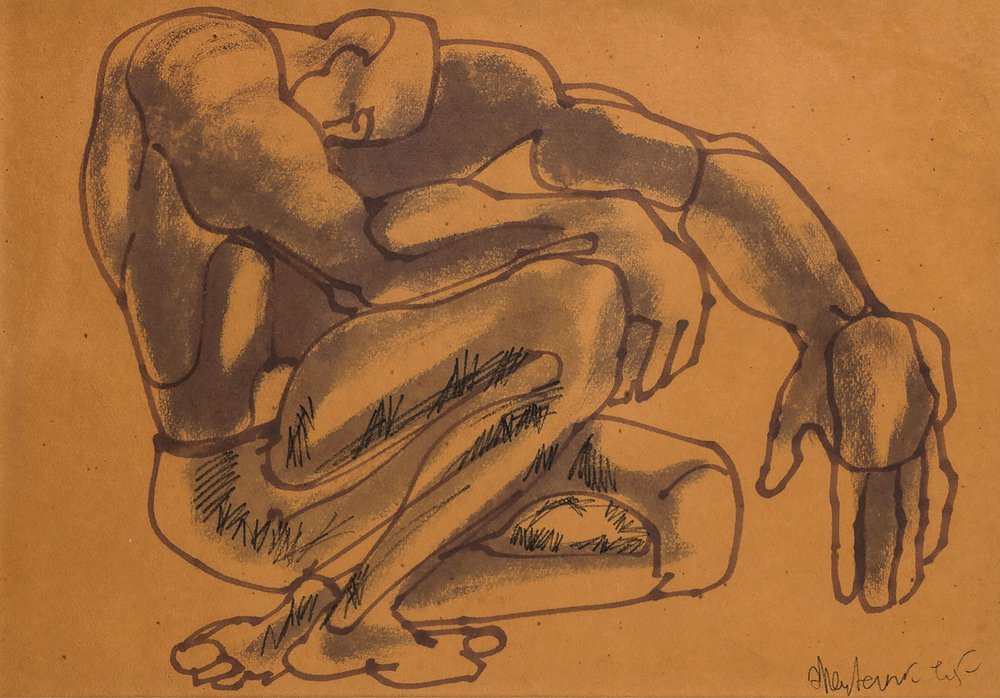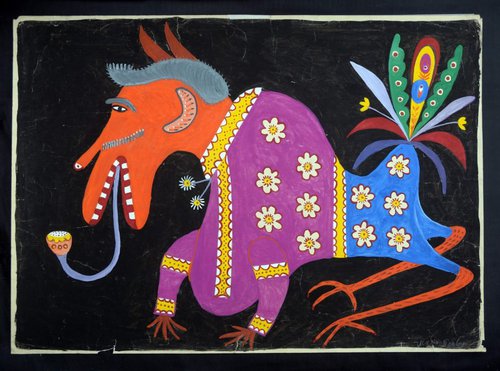Still in the Barracks: Bonhams Auction Keeps the Flame Alive

Ernst Neizvestny. Giant. Rebel Spirits. Non-Conformist Art from Important Collections. Courtesy of Bonhams
This Spring there has been little to write home about in terms of modern and contemporary Russian art offered at auction in Western Europe, despite a stronger presence last year, yet going against the tide, until 7th May Bonhams is offering a dedicated on-line auction of Soviet Non-Conformist art called Rebel Spirits.
With the context of ongoing gusty geopolitical and economical headwinds this Spring, the passing of the third year of the Russia-Ukraine conflict in February, the Trump bump quickly turning into the Trump slump, and the general downturn in the global art market, it is hard to find a sense of optimism anywhere.
Whilst by all accounts in Moscow the domestic art market remains buoyant, in the West the global art market has slumped by 12% over the past year according to the Art Basel and UBS art market report by Dr. Clare McAndrew and Russian art which traditionally has been less dependent on global trends, is still widely dispersed because of the economic sanctions even if prices are defying the gloomy mood at times. That said, with inflation expected to fall now from the heights of 2022–2024 it may bring investors back to art, something that was highlighted in McAndrew’s report.
My first auction of the season was at Sotheby’s in London on what was an unusually warm day in early March. I was particularly looking forward to seeing a rare 1924 print by El Lissitzky (1890–1941) of his famous self-portrait ‘The Constructor’ which sold later that night to a loud applause for one million Euros – just within a hair’s breadth of the world auction record. That morning, while wandering around the rooms where I first learnt my trade all those years ago, I discovered a few rather beautiful paintings hidden away amongst works by Bernard Buffet (1928–1999) in the Modern Day Auction. It was hard not to bask for a moment in the idyllic, sunny view of the ‘città verticale’ Positano painted by Ukrainian Russian futurist David Burliuk (1882–1967), a subject he returned to more than once throughout his life. Hardly a masterpiece by this exceptional artist, but it was the kind of painting which would cheer up any dark wall.
A quick check on art price revealed the seller had bought it a decade ago for 50,000 Euros, and I discovered it sold later for 60,000 Euros which sounds like a good profit – although that does not consider inflation and expensive auction house fees. Far luckier was the buyer of ‘Roses in a Vase’ a characteristic 1933 painting by Konstantin Korovin (1861–1939) which thanks to his rather slapdash signature, just three months previously had been miscatalogued and sold as ‘Modern School’ in a small Paris auction house where the experts had valued it at a mere 100–150 Euros! It sold for an impressive Euros 197,209, a good price for a late painting and what must have been a windfall for the clever person who spotted it.
Looking once again at McAndrew’s report, it is not all doom and gloom for the art market, because although major sales at the top end of the market are down, there has been some growth in the number of art works sold in what you might call the ‘art market for mere mortals’ – new collectors looking to spend under 50,000 Euros. McAndrew suggests it is ‘giving the market a broader and more diversified base for sales.’ I find it hard to talk of diversity in art collecting as it often seems like an elite, mainstream sport, however, the art market needs new collectors to oil the wheels, so with this and the prospect of lower interest rates on the horizon, perhaps in a few years’ time things will change for the better.
Meantime, Bonhams has an online auction dedicated to Soviet Non-conformism the third in a row since 2022, and the only auction house to offer such niche sales in the West. Their policy of conservative pricing should augur well, however, there are no masterpieces to act like a honeypot to attract the bees and bring more pre-sale interest, as well as much needed positive PR for the field. There are a few good, affordable finds for new collectors or those on tight budgets, among them a monumental ‘Crucifixion’ scene by Natalia Nesterova (1944–2022) painted in 1991 and once sold by Alexander Gertsman who represented her in New York. Estimated at Euros 2,000-4,000 it is a bargain, although a tough subject to hang in your living room. Among the highlights promoted by Bonhams is a 1979 Rabin painting called ‘Chateau à la fin de l’automne, although I much prefer his 1968 ‘Barracks Again’. It reflects better the artist’s poetics of dissidence, and the little lamp glowing from inside the blackness is soul-warming.
From the same decade, there is an abstract composition with playing cards by Vladimir Nemukhin (1925–2016) which was once exhibited at the Biennale of Dissent in Venice, a desirable provenance. There are numerous works on paper worth looking at, none more so than Oleg Vassiliev’s sketch for his 1994 ‘From the Past’, one of his most famous paintings, in which he appropriates an image of Vassily Polenov’s iconic ‘Grandmother’s Orchard’ and blends it with the light of a spectrum, it is on offer for Euros 3,000–5,000.
The Bonhams auction also has a very fine and well priced group of sculptures and works on paper by Ernst Neizvestny (1926–2016). I have been fascinated by Ernst Neizvestny since I discovered John Berger’s book about him many years ago when it was difficult to find his work at auction in the West not because it was rare but because there was just no market for his work - living up to his name which translates as ‘The Unknown One’ he had simply been forgotten about. If you are a collector whose walls are full, you might still find some space for a few small-scale sculptures by Neizvestny which you could pick up for a few thousand Euros in the auction, and if you are interested in finding out more about him start with Jean Mohr’s photographs published in Berger’s book showing his workshop in the late 1960s and early works which set the tone for what was to come.
As a teenager, Neizvestny was close to death in World War II when fighting the Germans behind enemy lines he was gravely wounded and lay waiting for help for what must have seemed like an eternity. His work is perhaps best understood as an expression of ‘undefined experience, both familiar and universal’ as Berger put it, representing inner elemental forces of mind and body which push outwards into being and form, shaped by both eros and thanatos.




















